
In SEO, you’ll hear plenty about keywords and how they affect your content rankings. But you don’t hear so much about Latent Semantic Indexing (LSI) and the influence it may have on SEO.
If you’re not familiar with the term, Webopedia.com defines LSI as an “algorithm used by search engines to determine what a page is about outside of specifically matching a search query text.” More clarification on this is below.
When used effectively, LSI can give your rankings a significant boost—and using it in your content may be easier than it sounds.
Let’s get started by explaining what LSI keywords are and why they’re important.
What are LSI Keywords?
Put simply, LSI keywords are terms semantically related to your subject. Each LSI keyword, groups of words, or phrase you use is relevant to the main keyword you’re targeting. But, they’re not always synonyms—LSI also searches for ideas commonly found in conjunction with your primary keywords.
When you include LSI keywords in your content, it helps Google understand the site’s topic by giving it context. LSI also makes it easier for Google to index your content and may give your site better visibility.
Here’s an example of LSI keywords.
If we use “cake recipe” as our search term, this is what we see:
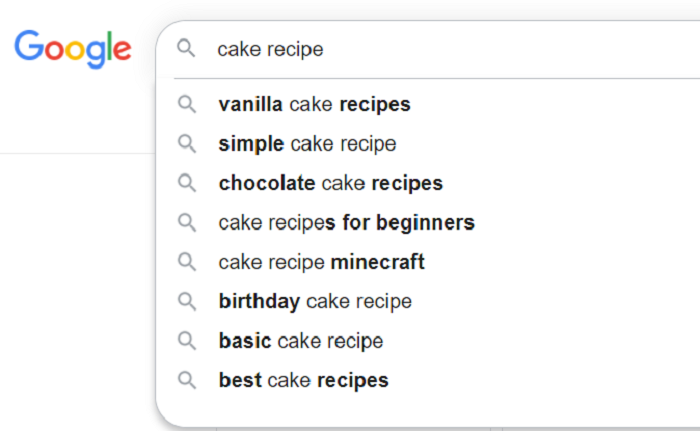
As you’ll notice, Google’s auto-suggest offers several additional search terms in bold. LSI keywords—these related words and phrases—give you a better idea of what consumers are searching for, allowing you to develop new content ideas.
The result? The possibility of ranking for multiple keywords and attracting a larger audience
Why Are LSI Keywords Important?
You’ve probably all heard of “keyword stuffing.” Not that long ago, that’s all it took to get a website ranked highly by search engines: repeating your keywords over and over and over.
Back then, some marketers scattered their target keywords liberally throughout their text, in headers, meta descriptions—basically everywhere. Although this was effective in getting ranked highly by search engines, there were downsides to this approach:
- The content often wasn’t relevant.
- The text was generally low quality.
- The searcher’s questions weren’t answered.
Through machine learning and AI, search engines have gotten smarter. For Google, this meant the introduction of the Hummingbird algorithm. Hummingbird combined new and old technology to deliver more intelligent results and emphasized quality content over keyword quantity.
In short, Hummingbird doesn’t analyze specific SEO keywords. Instead, it looks at the context of searchers’ questions, looking at relevance and intent.
As Google explains, while keywords are still of the utmost importance, their system also uses
…aggregated and anonymized interaction data to assess whether search results are relevant to queries. We transform that data into signals that help our machine-learned systems better estimate relevance.
Hummingbird also makes greater use of long-tail keywords.
Using LSI search terms in your overall SEO strategy is crucial because they:
- Allow for improved content quality by using related search terms
- Provide relevance to your content without keyword overuse
- Enable greater visibility for your content
- Offer more ranking opportunities as, by using LSI keywords, you can rank for related terms instead of just your keywords
- Limit your chances of Google penalties for frequent keyword use.
How to Find LSI Keywords
There are several ways you find multiple keywords that rank. Here, we’ll discuss several ways you can do so on Google.
1. Bold Words in SERP Results
When you search on Google, you’ll find related terms in SERP results. Google highlights these terms in bold. For example, if we use the term “camping gear,” we get the following suggestions:
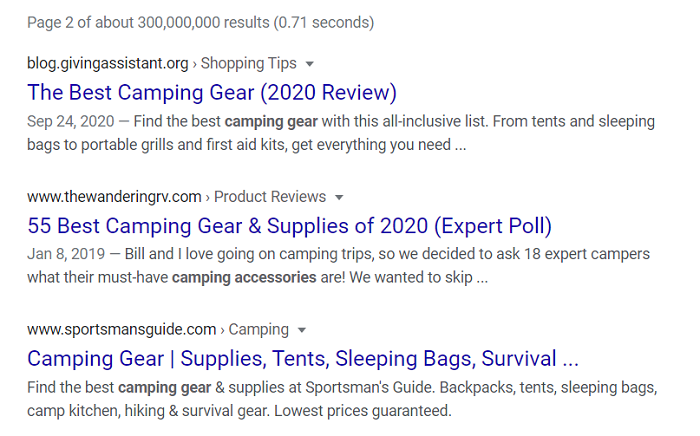
As you can see, it found the specific keywords, as well as the similar phrase “camping accessories.” If you kept searching, you’d likely also see words like “supplies,” “campsite,” and “camp.”
As a bonus, The SERP results make it easy to see the LSI keywords your competitors are targeting, too.
2. Using Google Autocomplete
If you use Google, you’ll know that it creates a list of related words every time you enter a search term. For instance, when we use “hiking,” we get the following suggestions:
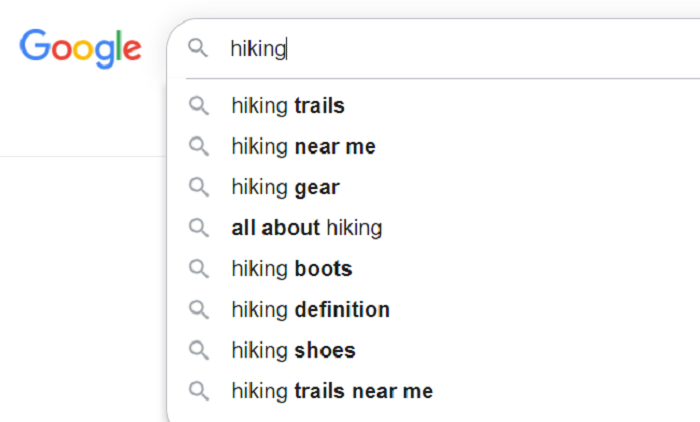
3. Topic Modeling
Topic modeling is an approach commonly used by content marketers. This allows for:
- More focused content
- Clear direction for your articles, website copy, etc.
- Creation of content more likely to rank
Just like LSI, topic modeling uses related words and phrases. The Content Marketing Institute explains, “Words and phrases are interrelated, and the idea behind topic modeling is to discover those relationships. When crawling your content, search engines aren’t just crawling for specific words, they’re seeking words with related meaning.”
They further explain how to structure your content to use topic modeling effectively:
- You should have your target keywords in your primary header, first paragraph, and as often as naturally possible.
- Your subheaders should be relevant, but they don’t necessarily need to include the keywords.
- Ideas that are related but not “on the nose” should go in the text. They still help with ranking.
4. Look For Related Searches in Google Search
If you scroll to the bottom of the Google search page, you’ll see a list of related searches. If we use the same example as above, we get:
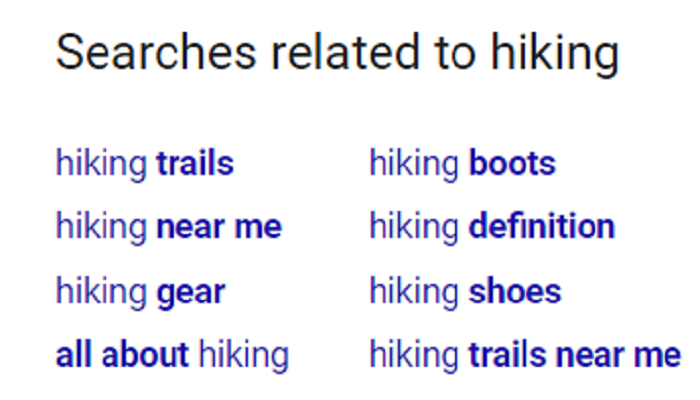
These are alternative terms you could use in your work to help improve your SEO results. You could also create brand new content, like blog posts, specifically about these searches.
5. People Also Ask
Another useful Google tool is the “people also ask” feature. This will show a list of questions people are looking for answers to.
Let’s look at “hiking” again. If you search for that and look at “People also ask,” you may see the following:
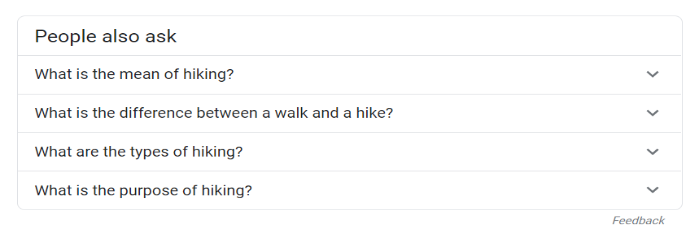
To enhance your content, consider shaping at least some of it around popular queries. You can pose these questions, especially has headers, in your content. This will provide readers with the answers they’re looking for.
6. Google Trends
Google Trends is a service Google provides to let you see some of the site’s most popular searches—and their relevant data.
When you go to trends.google.com, you’ll see an option to search. Type your keyword into this box.
For our purposes, let’s look for “apple.” The screenshot below is what you’ll see if you scroll to the bottom of the results page.

As you’ll see above, this will generate a list of related topics and queries suitable for LSI keywords.
Or, if you were hoping for apple the fruit, not the various other options, you may need to alter your keyword so your intent is more obvious.
Tools to Help Find LSI Keywords
There are many other easy-to-use tools for finding LSI keywords. Here are two examples.
Ubersuggest
Enter your search term, click “search” and my Ubersuggest tool will generate:
- Domain Overview
- Top SEO Pages
- Keyword Suggestions
- Content Ideas
- Backlink Data
In the example below, we used “yoga” as our search term. If you scroll down just a bit after searching, you’ll see a list of keyword suggestions.

As you can see, it doesn’t just show you the suggested keywords.
You can also look at related keywords, commonly searched questions relating to the keywords, keywords with prepositions, and comparisons like yoga vs. pilates. For full details, sign up for a free account.
LSI Graph
According to its tag line, LSI Graph allows you to “Generate LSI Keywords That Google LOVES.”
Some key features are:
- Traffic and competition analysis
- Unlimited, high-quality LSI keywords
- Find the best-ranked content in any niche
To get started, go to LSIgraph.com, enter your key phrase, click generate, and the site will create a list of LSI keywords and top-performing content.

Once again, we used “yoga” for our keyword search.
Note: This information shows up as side by side columns when you use the site; we split them into two images to make them easier to see.
This is the left-hand column. It shows you LSI keywords related to “yoga,” with information about their trends, volume, CPC, and more.
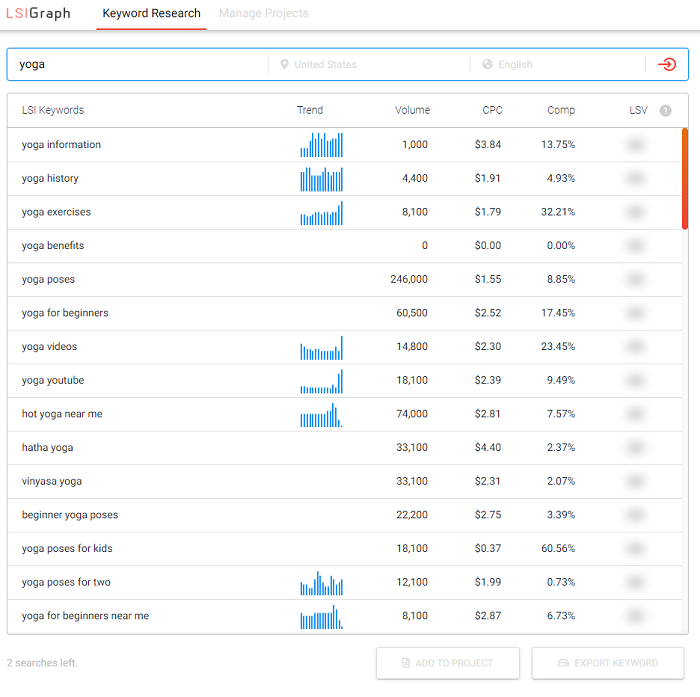
This second image, the right-hand column, shows you top-performing content related to “yoga.”
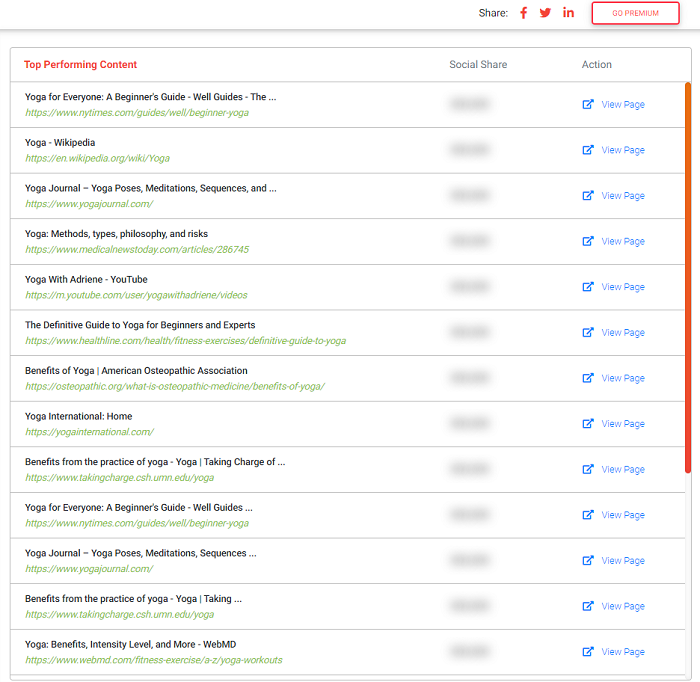
The basic version is free, but you can upgrade to premium starting at $27 per month.
Other Tools to Consider
Though those are great tools, there are others you could take a look at. A few good options are:
If you’re a WordPress user, you can access various other plug-ins to aid your SEO efforts further.
How To Use LSI Keywords
Now that you know the importance of LSI keywords and how to use various relevant tools, here are some basic guidelines for using your LSI keywords in your content:
- Focus on topics, not just keywords.
- Decide on the primary and core keywords you’re targeting.
- The LSI keywords you use should support and be relevant to your primary target keywords.
- Draw up a list of LSI keywords before writing. Many of the related terms will appear organically in your content. When you’ve finished writing, add the remaining target terms.
- When creating text, use LSI keywords in the same way you would regular keywords—naturally within the text.
- Ensure everything you write is high quality and useful to your readers.
When it comes to crafting your content, you can use LSI keywords throughout your site, including in:
- Pages and blog articles
- Headings, page titles, and images
- Anchor and alt text
- H2 and H3 subheadings and other HTML
- URLs and Meta tags
- Meta descriptions
- Conclusions
Update Old Content
Don’t just focus on creating new content— give past content an SEO boost by adding LSI keywords.
Doing this gives you another opportunity to get your older material discovered by Google and in front of an eager audience.
Optimize Images
Revamp old images by optimizing them with LSI keywords to improve their visibility. You can do this by merely renaming the images using your chosen LSI keywords. Don’t forget about the alt text when you do this.
Using LSI Keywords in Meta Data
Get your content noticed by Google by including LSI keywords in your metadata descriptions, image descriptions, and meta tags. Dot Com Infoway suggests using both your target keyword and an LSI keyword in your meta descriptions to enhance search results and increase your ranking.
Using LSI Keywords in HTML
Add LSI keywords to your heading, image, and title tags. Again, you’ll want to use words that appear natural to readers and search engines alike.
Using LSI Keywords in Paragraph Text
Include your target LSI keywords in the opening paragraphs of your pieces and throughout your posts. For natural-sounding content, ensure your keyword use is organic and well-spaced throughout the article.
In addition:
- Use related topics as subheadings and create paragraphs around them.
- Add one LSI keyword to your conclusion.
- Ask questions in your articles that answer searchers’ questions.
Using LSI Keywords in Anchor Text
To allow search engines to better understand your content, add variety to your anchor text with semantic keywords.
Conclusion
Search engines like Google have become increasingly sophisticated over the years, using machine learning and AI to understand entire pages and their topics rather than just target keywords.
The days of keyword stuffing and inferior quality content are long gone. Now, improving your content rankings means developing relevant, helpful, and high-quality material.
For an increased chance of broader visibility, incorporate LSI keywords into your strategy—and don’t forget to revisit old pieces when doing so.
Have you used LSI keywords or LSI tools as part of your SEO strategy?
The post How Does Latent Semantic Indexing Affect SEO appeared first on Neil Patel.
from Blog – Neil Patel https://ift.tt/3dsGiZ4

No comments:
Post a Comment